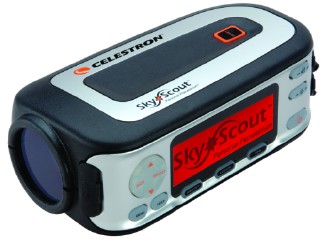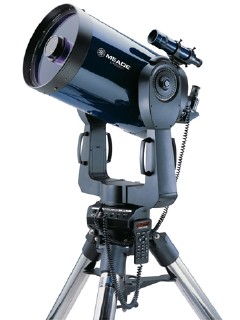GPS for Amateur Astronomers
It may surprise you that GPS gets used a lot in amateur astronomy, which in recent years has gotten awfully computerized. Now, you might not think that a technology that locates where you are on Earth has a lot to do with observing the rest of the universe, but it does: GPS satellites provide you with your exact position and the exact time — and this information can go a long way to figuring out where things are in the sky. Astronomers — or rather their computers — use GPS to help them know where to look.
Personal Planetariums
 First, let’s look at a relatively new category of educational gadget, the personal planetarium, exemplified by Celestron’s SkyScout (at right) and Meade’s competing mySKY. These battery-operated, handheld devices are used in one of two ways: they identify what you’re pointing them at, and they tell you where a given object is located. (Then they do a multimedia educational song and dance about said object.) They use GPS to figure out where you’re pointing from, and an accelerometer (to determine the angle you’re pointing upwards) and a compass to figure out what you’re pointing to. Date and time, latitude and longitude, direction and altitude angle — that’s all they need.
First, let’s look at a relatively new category of educational gadget, the personal planetarium, exemplified by Celestron’s SkyScout (at right) and Meade’s competing mySKY. These battery-operated, handheld devices are used in one of two ways: they identify what you’re pointing them at, and they tell you where a given object is located. (Then they do a multimedia educational song and dance about said object.) They use GPS to figure out where you’re pointing from, and an accelerometer (to determine the angle you’re pointing upwards) and a compass to figure out what you’re pointing to. Date and time, latitude and longitude, direction and altitude angle — that’s all they need.
The scary thing is, it actually works. They’re not telescopes, so they don’t need a high degree of precision. I own a SkyScout, and so long as there isn’t anything large and metallic nearby to futz with the compass, it works quite well: I point it at Betelgeuse and it says it’s Betelgeuse, for example. The compass is the weakest link, enough so that the SkyScout comes with shields for the battery; if I use it too near my car, it gets things wrong.
Telescopes
When it comes to telescopes themselves, GPS has been increasingly incorporated into computerized telescope mounts. A computerized “go-to” mount calculates where everything is in the sky based on the positions of known objects (it asks the user to centre one to three stars or planets in the eyepiece; telescopes require more precision than personal planetariums) as well as the date, time and location of the mount. These last three items are normally added by the user, but they can also be supplied by a GPS, which is both more convenient and more accurate. In some cases, the GPS is an accessory to be plugged into the mount that costs around $150 to $250; in more and more cases, however, the GPS comes built-in.
 Meade’s LX90, LX200 (at right) and ETX-LS series have built-in GPS, as does Celestron’s CPC series. Celestron also sells a GPS accessory unit for its telescope mounts that don’t come with built-in GPS, such as the NexStar, Advanced GT and CGE series, but it’s pretty expensive; one alternative is to use an adapter to connect a SkyScout and use its GPS receiver. Orion sells a GPS receiver
Meade’s LX90, LX200 (at right) and ETX-LS series have built-in GPS, as does Celestron’s CPC series. Celestron also sells a GPS accessory unit for its telescope mounts that don’t come with built-in GPS, such as the NexStar, Advanced GT and CGE series, but it’s pretty expensive; one alternative is to use an adapter to connect a SkyScout and use its GPS receiver. Orion sells a GPS receiver for its computerized equatorial mounts, as does Sky-Watcher (in Canada) for its (nearly identical) mounts.
Truth be told, some of these telescope/mount combinations and standalone mounts are quite large, whereas GPS is really only useful if your telescope mount is portable; an observatory’s telescope computer really only needs to have its lat/long coordinates entered once. If you observe from a few known locations, it’s probably not worth the expense to get a dedicated GPS for your telescope mount, not if you can simply look up the coordinates online, or use another GPS receiver, and enter them in yourself.
But in small telescope mounts, which could plausibly be moved from place to place, GPS could really be useful; unfortunately, these mounts tend to be pretty price-sensitive. Even so, I’d really like to see it become standard. Most of iOptron’s small telescope mounts come with built-in GPS; I’d like to see a NexStar with standard GPS in the future, for example.
- Buy Celestron SkyScout at Amazon.com
- Buy Meade mySKY at Amazon.com

Comments
blog comments powered by Disqus